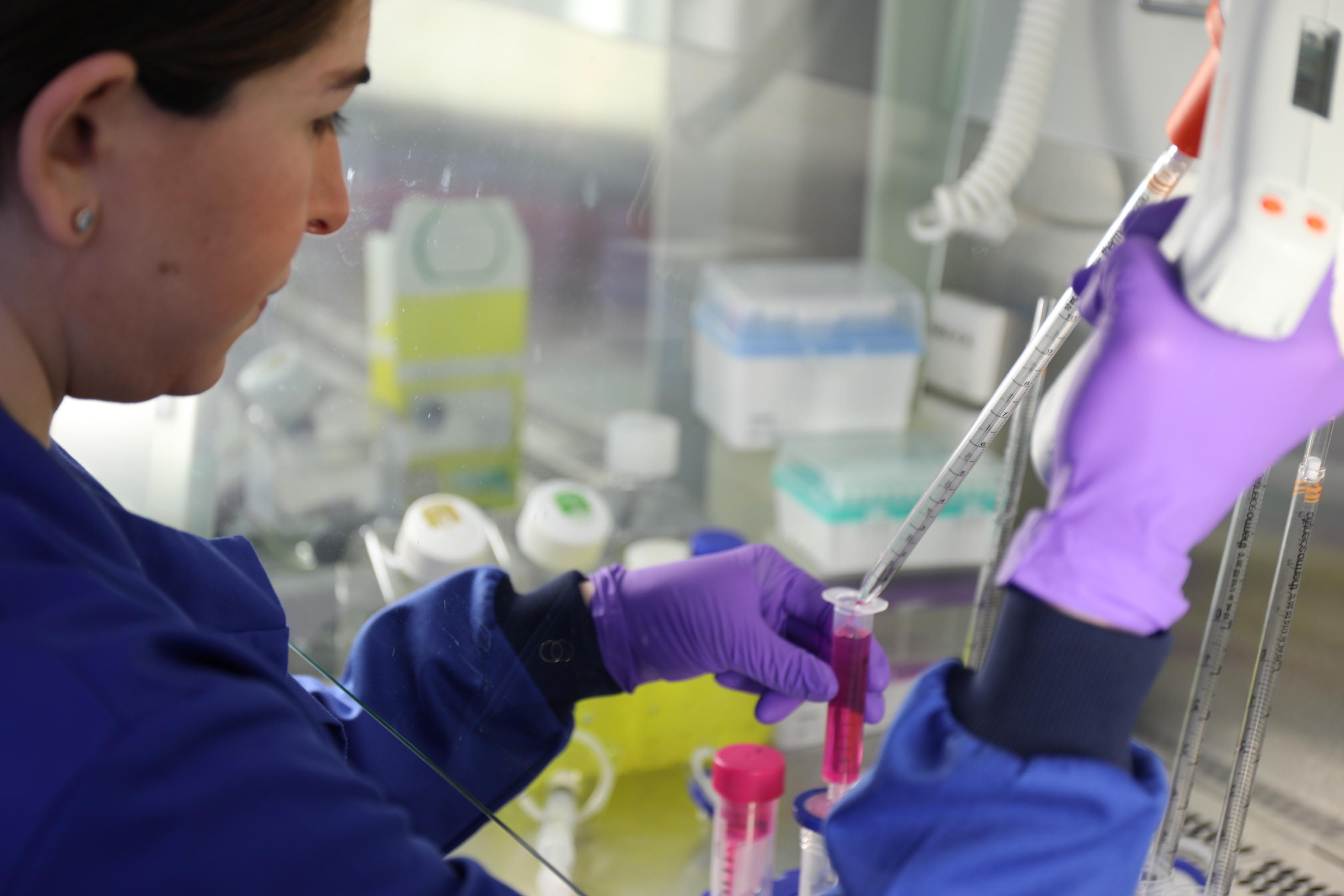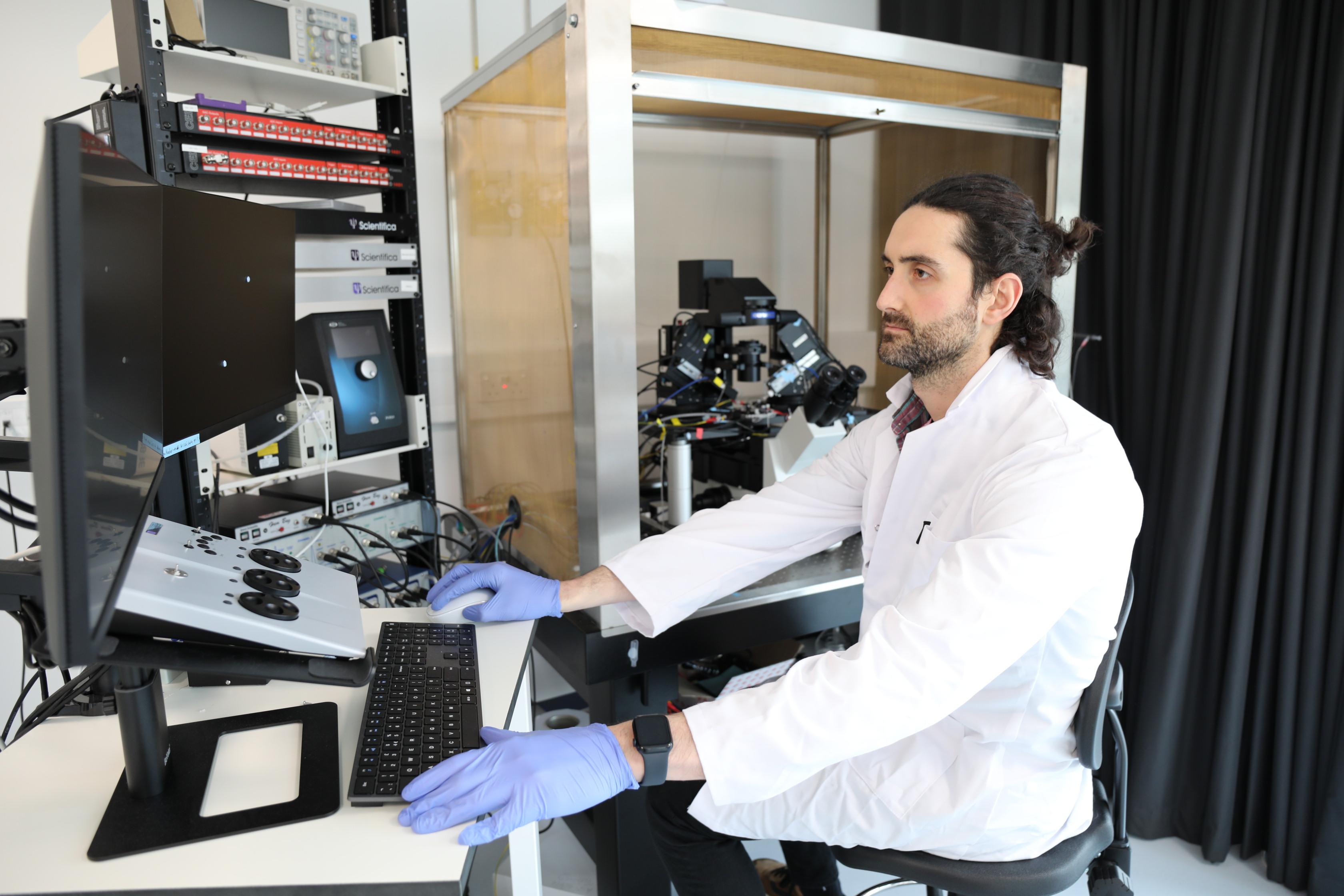
Building advanced therapies for neurological diseases
An interview with Dr Andy Murray, Co-Founder of Sania Therapeutics and former Group Leader at SWC, conducted by April Cashin-Garbutt
After discovering a way to evolve viruses to precisely target neural circuits, Dr Andy Murray knew this interesting science could lead to exciting therapeutic applications. Whilst Group Leader of the Murray Lab at SWC, Andy patented the technology platform and began his journey to co-found gene therapy company Sania Therapeutics.

Andy had met one of his fellow co-founders a few years earlier. Rob Brownstone, a Professor at the UCL Queen Square Institute of Neurology, who was previously at Dalhousie University in Canada. Andy and Rob both moved to London around the same time, and they started meeting regularly to discuss their shared research interests.
These initial conversations led to the idea of a potential spinout and that’s when they were introduced to Raj Dattani, who would become the third co-founder and provide the commercial expertise to help build the company.
First of all, they needed to give the company a name. They started by taking the first letters from all their children’s names and rearranging them to come up with words. Whilst they all really like the first name they arrived at, after a quick Google search they realised it was an Italian swear word! And so back to the drawing board they went and eventually arrived at Sania Therapeutics.

In this interview, Andy shares the mission of Sania Therapeutics, how this builds on his previous research at SWC and advice for academics interested in starting a spinout.
What’s the mission of Sania Therapeutics and how does it differ from other gene therapy companies?
At Sania Therapeutics, we are trying to develop genetic therapies that target neural circuits and introduce genes that normalise the activity of those circuits in different diseases.
There are many kinds of neuro-based gene therapy companies and what they are mostly trying to do is introduce a new copy of a gene into a person with a particular mutation. What we are doing is a bit different and it is similar to the kinds of research we were doing in animals at SWC. We are targeting particular parts of the nervous system that are malfunctioning and basically trying to fix them.
Our first clinical pathway is for a condition called spasticity, which manifests as an over-contraction of muscles. Many people with spasticity will have sudden unexpected contractions of muscles meaning they effectively can’t move, sometimes their muscles are so stiff and contracted they cannot even sit in a chair.
Spasticity occurs because the motor neuron in the spinal cord is too active. What we are trying to develop is a virus that targets those motor neurons and introduces a gene into them and then regulates the activity, which allows the patients to move more normally.

What makes the gene therapies you are developing novel?
We are actually still debating whether we should call them gene therapies as what we are developing is quite different!
Other gene therapies take a patient population who has a particular mutation in a gene, for example spinal muscular atrophy, and give them an injection of a virus that codes for the correct copy of that gene. Essentially, they are just trying to replace that gene.
What we are trying to do is more of a genetic therapy. We are not replacing any genes. We are introducing a new gene to alter neuronal activity and treat the patient that way.

In addition to spasticity, what other conditions are you working on in the pipeline?
Spasticity is what we are focusing on first, but we have several other circuit based therapies that we are thinking about internally. We think the technology we have is broadly applicable to a number of disorders in the central and peripheral nervous system. We are doing some experiments and analysis in house at the moment to work out where we would have the most impact.

How does this link to the research you were doing at SWC?
The research my lab was doing at SWC focused on how the brain and spinal cord generate movements, and the role of different cells types such as motor neurons, so there is a lot of overlap there with the general research interest. More specifically, when I was at the SWC we came up with this technology platform, which is a cell culture system where you can evolve different types of viruses to target particular circuits.
My lab at SWC focused on adeno-associated virus (AAV) and rabies virus and we worked out that you could mutate the viruses in such a way so that they target particular circuits. We patented that through UCL who own the IP and we have licensed that technology platform back into Sania Therapeutics.
What stage is the company currently at?
We’re currently in the early R&D stage. We’re developing a lot of the technology, building the viruses and thinking about how to build the complete therapies. This involves doing lots of experiments in the lab, so in some sense quite similar work to what we were doing at the SWC.
We are now thinking about the first small animal trials in spasticity and we hope to start those in the next couple of months. A year or so after that we will move onto larger animal trials and we hope to have first-in-human trials in the next 3-4 years.

How is the company funded?
It is all private investment. We’re funded by a combination of a couple of venture capital firms and angel investors.
What has the journey been like so far?
Fun and stressful! It has been quite varied but also very exciting. It took some time to get to this point. We started by just patenting the technology and then there was a long period when we were figuring out what to do and whether to form a company. I had no business background myself but I was fortunate to have a couple of friends in the US who had started companies so I asked them for advice.
Once we had decided we wanted to start a company, we began talking to people about investing. This took a long time, around a year. We also had to negotiate with UCL about the license to the patent. But once we had commitments for the money we needed and the IP license, then things started moving relatively quickly.
We closed our investment round in March 2022 and since then we have had our lab space built and we’ve been able to hire 7 people full time and we’re still looking for 3-4 more. Since March things have accelerated very quickly, both on the science side and with more administrative areas of building the company. I’m fortunate that we have a great team at Sania who have been able to push the company forward.
Did you always want to build your own company? If not, what inspired you to move in this direction?
It has always been something I’ve been interested in, but never had chance to explore. It was more of a gradual journey of exploring some interesting science that could have a therapeutic application. We realised that the best way to do this was to have a company and get private investment. Then it was a personal decision of whether to get someone else to manage the company, or to do it myself. The final decision came quite late, but I was always edging towards it.

How did your experience as a Group Leader at SWC equip you with some of the knowledge and skills you needed to start your own company?
The experience of managing people and projects at SWC was really useful. There are a lot of similarities with running a lab, as I am helping design experiments and managing budgets. We also use much of the same equipment in the company that we did in the lab and people have similar backgrounds.
At SWC, I was surrounded by senior colleagues and I found this very helpful as I picked up their management tips. Also some people from SWC moved across to Sania Therapeutics including Miranda Matthews and Alba Guijarro Belmar from my lab and also Yiota Demosthenous, who used to be in the Viral Vector Core at SWC.

How did SWC support you to make the move?
SWC were really great and very flexible, they were open to discussing what I wanted to do and how best to support both myself and the people in my lab. Initially, I thought that there would be a lot of work to do in the first 6-12 months as the company was being formed and so I asked to spend the majority of my time at Sania while maintaining my lab part time. We had a lot of discussions about how that would work, and they were very supportive.
Once I started at the company, I realised it was much harder to split my time than I had imagined so I realised I had to choose!
Do you still interact with the SWC community?
Yes, I am still the primary supervisor for two students that are just writing up their PhDs and I am also co-supervisor for a couple of other students at SWC. I have an honorary contract so I still go into the building and interact with people there.
What advice would you give to academics looking to start a company?
I think the key is to be very persistent. There may be times when it looks like things won’t work out, or there are just too many challenges to overcome. For example, raising funding or dealing with various legal matters can take a lot of effort. You will come across many hurdles but you have to keep pushing.
You might also be scared that you don’t have the right experience, for example if you don’t have a business or financial background, or knowledge of the legal side of things. But all of this stuff is learnable. There is nothing intrinsically too complicated, you just need to learn how everything works – companies, shares, investments and so forth.
What has been the most surprising thing you’ve learned so far?
I am surprised how similar things are in terms of the science. In terms of managing the project and experiments that we do, and even the people, it is very similar to what we were doing before. But the pace we are able to do things is quite surprising. Being a small company, we can move much more quickly than a larger institution. We can iterate on experiments more quickly, change the allocation of resources as we need to, do whatever it takes to get us to the clinic as quickly and efficiently as possible.
Is there anything you would have done differently?
There are lots of small things we could have done differently to speed up the spinout process but overall I am happy with where things ended up. It could have been less stressful in some ways, but that made it fun!

What are the next steps for Sania Therapeutics? Will you be hiring again soon?
We’re hiring at the moment, we have some adverts out now for 3-4 more scientists.
Over the next two years we are looking to build up enough data and experimental proof to get the next round of investment called Series A. This larger pool of investment will allow us to expand the company further and enable larger animal trials, move into humans and expand into other therapies.
At the moment, we’re thinking about the other therapies we can expand into and over the next couple of years we will aim to build up that data and grow from there.
To find out more visit the Sania Therapeutics website or follow them on LinkedIn.

